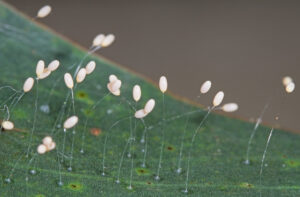Every insect has an enemy
By Denis Crawford
We all know about the natural enemies of pest insects, but did you know that beneficial insects also have their enemies?
I have often said “for every insect out there, there is probably another insect that wants to feed on it or breed in it”. This even applies to the beneficial insects we are familiar with. Beneficial insects, the predators and parasites, are attacked in several ways. There are parasites of predators, predators of predators, predators of parasites, and even parasites of parasites. Here are a few examples.
Firstly, to parasites of predators. Let’s look at what happens to predators we should all be familiar with – ladybird beetles and lacewings. Ladybird beetles must be one of the most recognisable beneficial insects, but they don’t have it all their own way as there are several predators and parasites that attack them. For example, the parasitic wasp Dinocampus coccinellae. A female wasp lays an egg in a ladybird beetle and the hatching wasp grub develops through four instars. Just prior to emerging from the host beetle, the wasp grub secretes chemicals which paralyses the ladybird. The wasp grub then emerges and pupates between the legs of the still twitching ladybird beetle. There is no safer place for a vulnerable insect pupa than between the legs of a predatory ladybird! After several days an adult wasp emerges from the pupa. According to research in France, about 25% of parasitised ladybirds recover normal behaviour after the emergence of the adult wasp!
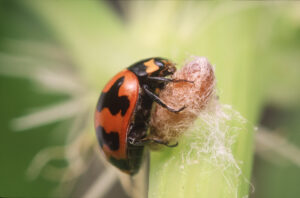
I have written previously in Pest Files about female green lacewings (Chrysopidae) laying eggs on stalks. The stalks prevent the hatching lacewing larvae from eating each other. However, the stalks provide no protection from tiny parasitic wasps which lay their eggs inside the lacewing eggs. These specialist wasps can be members of several wasp families (Encyrtidae, Scelionidae and Trichogrammatidae) and are technically known as ‘egg parasitoids’. A wasp larva hatches from its egg within the lacewing egg and feeds on the egg contents. The wasp larva then pupates inside the lacewing egg and eventually emerges as an adult wasp.
Predators of predators is quite straightforward. An obvious example is praying mantids. They are instantly recognisable insects with their triangular heads and their characteristic way of standing with forelegs held together as if they were praying, hence ‘praying’ mantid. Their forelegs are armed with rows of spines (described taxonomically as ‘raptorial’). When prey is within reach, the forelegs shoot forward and the victim is impaled and held tight with the spines, and then lifted up and eaten alive. Mantids are generalist predators and will eat anything they can get a hold of – pest insects, beneficial insects, or benign insects. They don’t discriminate.
Predators of parasites is also pretty straightforward. Once again it could be a praying mantid as mentioned above, but the example of a predator feeding on a parasite shown here involves a robber fly. Sometimes called ‘assassin flies’, robber flies are members of the fly family Asilidae, and there are about 600 species found in Australia. Robber flies are predators of just about any flying insect they can catch including other flies, dragonflies, wasps, bees, and even adult beetles. The image printed here shows a robber fly feeding on a male ‘flower wasp’ of the family Tiphiidae – a parasite of scarab beetle grubs. The literature tells us that robber flies may catch parasitic wasps of several families, and some of those wasps are the natural enemies of some pest insects.
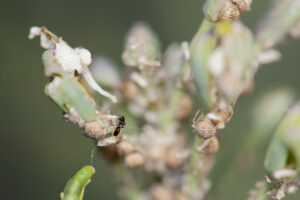
I find parasites of parasites, known as hyperparasites, particularly fascinating. A parasite which breeds in the parasite of a host insect is always known as a hyperparasite of the host. Here is an example. The cabbage aphid (Brevicoryne brassicae) is an introduced sap-sucking pest of brassica crops. The wasp Diaeretiella rapae is known as the primary parasite of cabbage aphid. Other wasps which arrive to attack Diaeretiella rapae are known as hyperparasites of cabbage aphid.
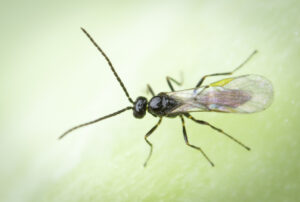
This is what happens when the primary parasite, Diaeretiella rapae, arrives. A female wasp lays a single egg into the bodies of cabbage aphids. The wasp larva feeds on tissues within the aphid body, killing it after a few days. By the time wasp larvae are fully grown, the empty aphid bodies turn into hardened, bronze-coloured mummies. An adult wasp then emerges through a circular hole cut in the back of the mummy. That’s what normally happens, unless the hyperparasites arrive.
There are several wasps that are hyperparasites of cabbage aphids, and they work in a couple of different ways. A female wasp of the genus Alloxysta deposits her egg inside the Diaeretiella rapae larva while it is still feeding inside the live cabbage aphid – but before the aphid has turned into a mummy. Other female wasps of the genera Pachyneuron and Dendrocerus lay their egg on the surface of a Diaeretiella rapae larva after the aphid has turned into a mummy. The hyperparasites of cabbage aphid is but one example. There are also hyperparasites of many other pest aphids, as well as caterpillars, psyllids, and sawflies etc.
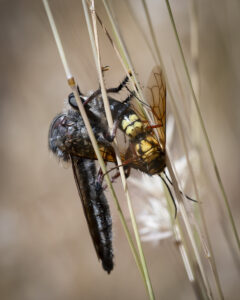
The examples outlined above make it seem like beneficial insects are under attack from many quarters. How can beneficial insects be effective then? The answer lies in diversity. There is usually more than one species of beneficial insect working on a pest insect infestation at any one time. For example, an aphid infestation may be simultaneously under attack from parasitic wasps, ladybird beetles (adults and larvae) and the larvae of hover flies.
What happens if a wasp parasitises lots of aphids but later a ladybird beetle arrives and feeds on parasitised aphids as well as unparasitised aphids? From a pest control point of view, it’s all good – the aphids are being controlled. The parasitic wasps will be fine because some parasitised aphids will be missed by the ladybird, and the wasps inside will eventually emerge and fly off to parasitise other aphids elsewhere.
Main photo: Stalked lacewing eggs (Image by Denis Crawford)

